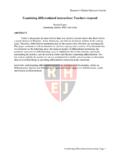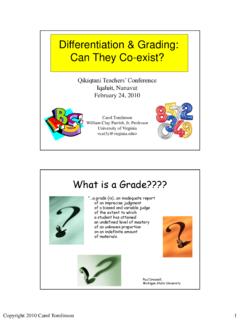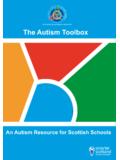Transcription of Investigating the Impact of Differentiated …
1 Investigating the Impact of Differentiated Instruction in Mixed Ability Classrooms: It's Impact on the Quality and Equity Dimensions of Education Effectiveness Valiande A. Stavroula Cyprus Pedagogical Institute Kyriakides Leonidas University of Cyprus Koutselini Mary University of Cyprus Paper presented at the : International Congress for School Effectiveness and Improvement 2011. January, 2011. 1. Investigating the Impact of Differentiated Instruction in Mixed Ability Classrooms: It's Impact on the Quality and Equity Dimensions of Education Effectiveness Valiande A.
2 Stavroula, Kyriakides Leonidas, Koutselini Mary Abstract This paper presents the results of a study concerning the application of Differentiated instruction in mixed ability classes, in which 24 elementary classes of 479 Cypriot pupils participated. The study provides evidence about the effect that systematic Differentiated instruction in mixed ability classes has on students' achievement. The results of the experimental group of the research that had received Differentiated instruction were compared by multilevel regression with the results of the control group that had not received Differentiated instruction.
3 The comparison aimed at Investigating the difference in achievement between the two groups and the identification of other factors that affected students' achievement between and within these groups. A multilevel structure equation model was used to demonstrate the relations and the Impact of the change of teaching practices, monitored by a Differentiated instruction observation key, over students'. achievement. Along with the main research question determining the Impact of Differentiated teaching on students' achievement, research results gave substantial evidence over the dimensions of quality and equity of education effectiveness.
4 Quality and equity dimensions of education effectiveness consists of main conflict issues for differentiation instruction in mixed ability classrooms. Based on the results of the study presented, this articles' main target is to discuss how Differentiated instruction can promote equity and quality for all in mixed ability classrooms. Introduction Educational effectiveness has been one of the main problems encountered in modern societies' educational systems. Research reveals that educational systems fail to meet the challenge of providing quality and equity, leading to achievement gap (Brooks-Gunn &.)
5 Duncan, 1997; De Civita, Pagani, Vitaro, & Tremblay, 2004; Strant, 1999), between different groups of students. Evidence supports that achievement gap increases during schooling (Fryer & Levitt, 2004, 2006). These findings declare that education has failed to fulfill its mediating role and educational systems have not found the way to be effective for all. Narrowing the achievement gap has been the main aim of socially directed educational systems, in order to achieve equity. Although many curriculum reforms and policies were formed based on providing and promoting equity trough enchainment of quality in education, the results of such efforts around the globe have not been very promising.
6 Traditional and undifferentiated instructive approaches that do not facilitate the construction of knowledge for all students in mixed ability classrooms are seen as one of the basic factors causing this problem (Valiande, 2010). Supporters of differentiation and its effectiveness state that it is the only way for effective teaching for all students in mixed ability classrooms (Tomlinson, 1999, 2001; Koutselini, 2006). differentiation guides the planning and instruction in mixed ability classrooms based on students and their needs, facilitating the construction of knowledge for each and every student based on its prior knowledge and dexterities.
7 The study presented in this article, is mainly an effort to put differentiation in practice, by fulfilling the key presuppositions for effective Differentiated instruction and evaluating its implementation and its effectiveness, aiming at finding a way to act in the best interest of all students in mixed ability classes. 2. Differentiated Instruction Theoretical Background of differentiation The technocratic and positivist tradition that led to knowledge and content oriented educational practices has raised strong criticism bared to its failure to mediate society's needs (Apple, 2003; Guba & Lincoln, 1989; Habermas, 1978; Giddens, 1976).
8 The limitations and weaknesses of the technocratic tradition bring out the need for new theoretical framework for educational practices. A theoretical framework, in which students are the center of any decision and any action to be taken. A theory and practice on how to guide students in their own learning path. Students are not commodities and schools are not factories producing specific kind of working units. differentiation entails a solid proposal of such framework and is presented as the answer to the limitations and weaknesses of the technocratic tradition (Valiande, 2010).
9 The theory of Differentiated instruction is based mainly on the theory of social constructivism (Vygotsky, 1978) and emphasizes the active participation of students in the learning process where the construction of knowledge emerges due to the interactions of students with their environment (other students, teachers, knowledge, educational material etc). The teacher, who entails the key to a successful Differentiated instruction (Valiande &. Koutselini, 2008, 2009;Valiande, 2010), is challenged to facilitate learning for students of different readiness level, interests, learning profile (Tomlinson, 2003), socio-economic and cultural capital and psycho-emotional characteristics, all features that can affect the construction procedure of new knowledge.
10 Differentiated instruction that was first proposed as a teaching practice by Tomlinson, (1999) is seen as the change of the teaching process based on teaching routines that correspond to the large span of students' differences in mixed ability classrooms, such as student's readiness, interests and learning style (Tomlinson 1999, 2001). Furthermore, differentiation can be defined as the instructive approach by which teachers modify the curriculum, their teaching methods, the educational sources used, the learning activities and the evaluation methods according to and in correspondence with students' Differentiated needs, in order to maximize the learning opportunities for every student (Bearne,1996).









